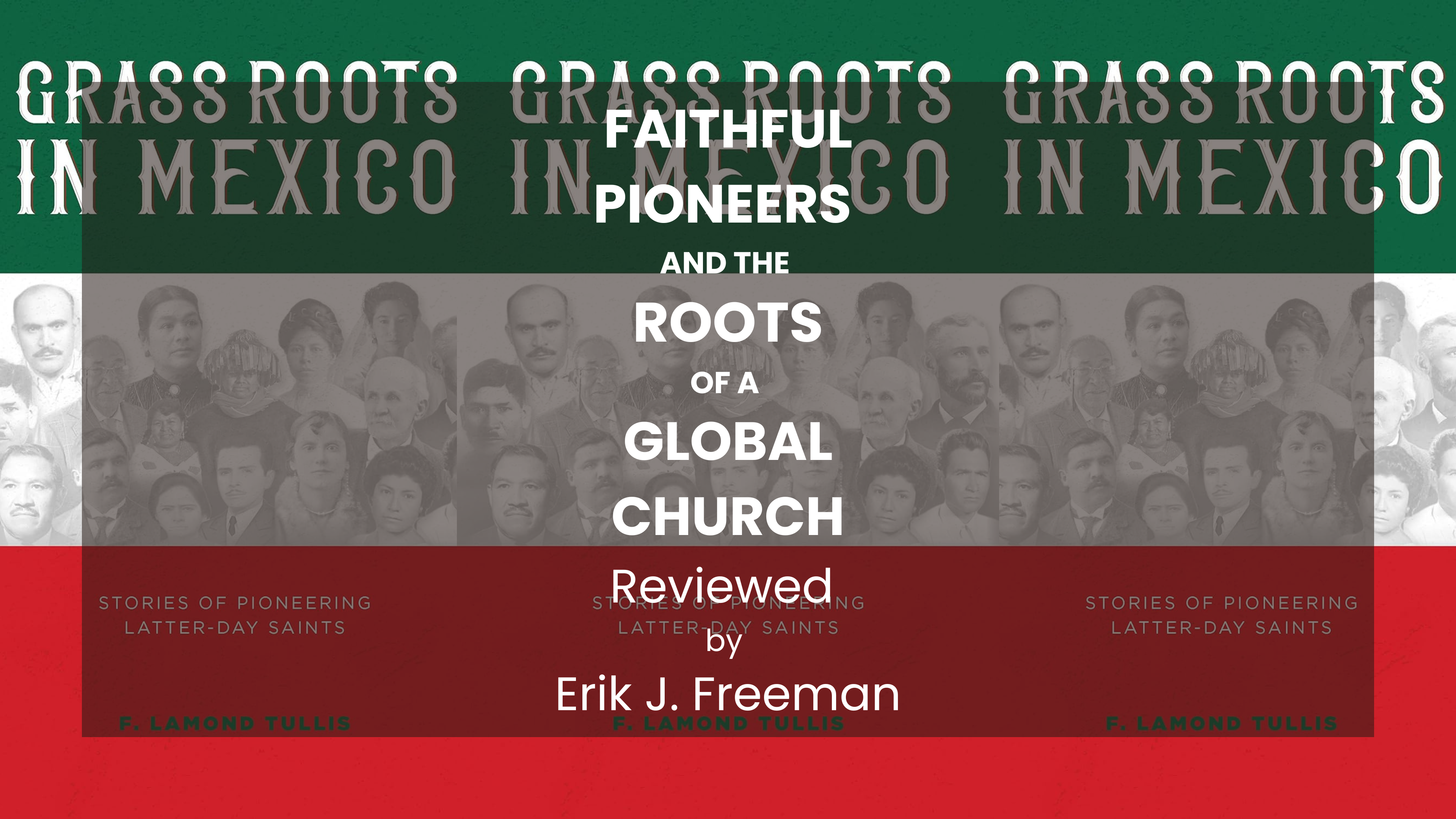Articles/Essays – Volume 56, No. 4
Faithful Pioneers and the Roots of a Global Church | F. LaMond Tullis, Grass Roots in Mexico:Stories of Pioneering Latter-day Saints
F. LaMond Tullis’s Grass Roots in Mexico: Stories of Pioneering Latter-day Saints explores the lives of nineteen people who influenced the founding and growth of Mormonism in Mexico. Tullis is a retired professor of political science at Brigham Young University and has been a pioneer in the scholarship of transnational Mormonism. In the 1970s, he traveled to Latin America on LDS Church funds to undertake oral history interviews for what was supposed to become a volume celebrating the 150th anniversary of Mormonism’s founding. That book never came about, but since the 1980s, Tullis has built upon his original research in Latin America and has published multiple books and journal articles about international Mormonism for academic and religious audiences. Grass Roots in Mexico is primarily written for a mainstream LDS readership. Those looking for faith-promoting stories about Mexicans devoted to Utah’s Church of Jesus Christ of Latter-day Saints will find this book most useful.
Grass Roots is separated into two sections. The first section is a brief historical synopsis of Mormonism in Mexico, where Tullis summarizes over 150 years of LDS Mexican history in two chapters. The second section is a series of nineteen chapters of varying length that focus on individual Mexican Mormon “pioneers.” These vignettes explore the lives of complex individuals who searched for meaning in life and found the Latter-day Saints. The book’s argument is primarily that people from various geographic, educational, socioeconomic, and political backgrounds helped build the LDS Church’s foundations in Mexico. The one thematic connection between all the people in this book is their persistent faith in the mainstream Church of Jesus Christ of Latter-day Saints.
The vignettes are the book’s strength, especially the ones that highlight the lives of working-class, non-white people—particularly women. One example is the story of Jesuita Mera de Monroy (1854–1937), who never attended school because of her family’s poverty. Still, as a young mother, she fought to ensure that her many children (she had thirteen) received an education. Due to their schooling, some of Monroy’s children became teachers and ranch administrators in Hidalgo (133). One of Monroy’s daughters married an American Mormon, and one of her sons became a Latter-day Saint branch president. The Monroy family’s embrace of Mormonism, however, caused problems. During the Mexican Revolution, followers of Emiliano Zapata attacked the Monroy family’s Mormon compound, believing they were aligned with the American government and harbored weapons. The Zapatista revolutionaries even killed Monroy’s son, whom Tullis calls a “martyr” (xvii).[1]
Monroy’s vignette and numerous others hint at important political and social issues relating to Mexican Mormonism. Isaías Juárez’s story is one example. Juárez helped found the national peasant union (Confederación Nacional Campesina) and was deeply involved in labor organization and radical politics during the 1920s. At the same time, he served as the branch president and district president for the Latter-day Saints (173–76). Juárez’s story alone suggests the possibility for future scholars to analyze the relationship between radical politics and religion from a Mexican Mormon lens. Furthermore, the first Mormon convert in Mexico City, Plotino Rhodakanaty, was a founder of the Mexican socialist and anarchist movement.[2] Rhodakanaty’s story, however, did not appear in the book, likely because he eventually distanced himself from the mainstream Church.
Tullis rarely mentions polygamy, even though the Mormons who founded colonies in the Mexican states of Sonora and Chihuahua fled the United States to practice plural marriage. Indeed, numerous fundamentalist Mormon groups continue to exist throughout Mexico today. Tullis also dismisses the critical concerns of the Third Convention, a movement that included one-third of the Mormons in central Mexico during the 1930s. Members of the Third Convention were excommunicated in 1936 after petitioning the Church in Salt Lake City for more local autonomy and Mexican leadership. For ten years, Conventionists baptized, preached, and held church services outside Salt Lake City’s dictates. In 1946, the Mormon president in Utah, George Albert Smith, traveled to Mexico to ask the Conventionists to return. He reinstated many Conventionists to the mainstream organization without rebaptism. For Tullis, the Conventionists were “dissidents” who broke away from the Church because they did “not like some of the Anglo-European mission presidents” (17). Yet the complaint of the Third Convention, specifically that the mainstream LDS Church was directed almost entirely by white Americans, continues to concern many racial minorities and Mormons living outside of the United States.
This book rightly shows how Mormonism is not only an American phenomenon, and Tullis aptly tells stories about fascinating people often marginalized in the study of Mormon history. Yet the book’s silences illustrate the need for a deeper understanding of Mormonism in Mexico.
F. LaMond Tullis, Grass Roots in Mexico: Stories of Pioneering Latter-day Saints. Provo: Religious Studies Center, Brigham Young University; Salt Lake City: Deseret Book, 2021. 331 pp. Hardcover: $27.99. IBSN: 9781950304271.
Note: The Dialogue Foundation provides the web format of this article as a courtesy. There may be unintentional differences from the printed version. For citational and bibliographical purposes, please use the printed version or the PDFs provided online and on JSTOR.
[1] Tullis also recently wrote an entire book on the “martyrdom” of Rafael Monroy and Vicente Morales, which one author claims is “reminiscent of the martyrdom of Joseph and Hyrum Smith.” See F. LaMond Tullis, Martyrs in Mexico: A Mormon Story of Revolution and Redemption (Salt Lake City: Deseret Book, 2018).
[2] See Bill Smith and Jared M. Tamez, “Plotino C. Rhodakanaty: Mormonism’s Greek Austrian Mexican Socialist,” in Just South of Zion: The Mormons in Mexico and Its Borderlands, edited by Jason H. Dormady and Jared M. Tamez (Albuquerque: University of New Mexico Press, 2015), 55–73.


 Back to full Issue
Back to full Issue

